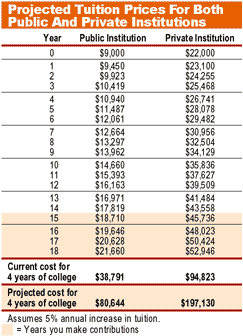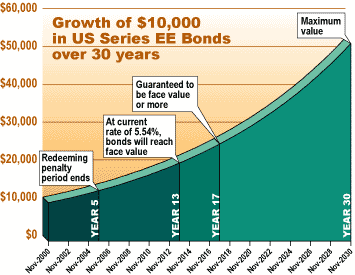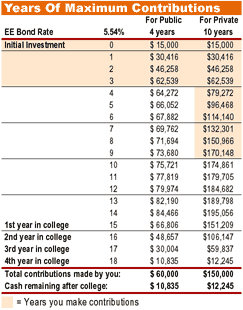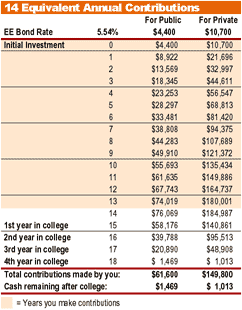
HOT TOPICS LIST
- Strategies
- Stocks
- Buy
- Investing
- Brokers
- Psychology
- Interviews
- Accumulate
- Sell
- Hold
- Spotlight
- Websites
- Candlestick Corner
- Gold & Metals
- Options Trading
LIST OF TOPICS
FINANCIAL PLANNING
Saving For College
01/26/01 11:58:33 AM PSTby Han Kim
US Series EE savings bonds to the rescue!
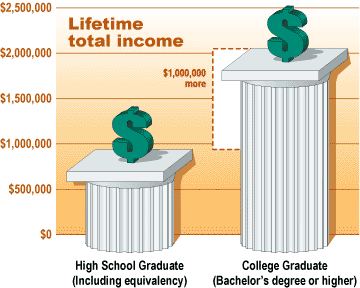
It's getting harder and harder to find a decent paying job with just a high school degree. These days, a college education is virtually a must in order to get ahead. The 1999 US Census shows the average income for high school graduates is $23,410. For college graduates, the average income is more than double that amount at $51,251 (in 1998 dollars). Over the working lifetime of the two graduates, the college graduate will likely make more than $1 million more than the high school graduate (Figure 1). According to the College Board, a national, nonprofit association dedicated to preparing students for college, tuition and expenses for public and private colleges are increasing at a rate of about 5% a year -- and this from an already high price tag. The average total cost for a four-year public institution of higher learning in the US in 2000 was $9,000 per year, and $22,000 for a private institution. Over four years, the total pricetag for a college education exceeds $38,000 for the public school attendee and $94,000 for the private school student. And if you plan for your child to attend college about 15 years from now, the total cost is estimated to more than double (Figure 2). That's $80,000 for four years of public college and $197,000 for a private institution!
Your options can be divided into two broad categories: a savings approach and an investment approach. With a savings approach, you will know exactly how much your initial investment should be in order to reach your goals. The savings approach may involve opening a special savings account, putting your money in certificates of deposit, or buying US Series EE savings bonds, which we will discuss later. You are guaranteed a certain level of interest on these savings products. The investment approach is more speculative. While the possibilities for greater returns exist, the risk of losing some or all of your investment is much greater than in the savings approach. Investment approaches include everything from brokerage accounts to 529 plans and uniform gifts/transfers to minors accounts. No single plan will work for every situation; you may need to use more than one method to meet your goals. Consider the following guidelines when choosing the plan that will have the greatest benefit for your family.
In this article, I will introduce you to the US Series EE savings bond, a choice that falls under the investment approach category. EE savings bonds are generally a good instrument to use for college savings because of their liquidity, tax advantages, low risk, and low costs. US SERIES EE SAVINGS BOND If "play it safe" is your motto, then a savings approach may be your best choice. Many of you are probably familiar with savings approaches like those available in banks. The low risk of the savings approach is alluring to many who want to play it safe. With US Series EE savings bonds, you are not dealing with the banks, but directly with the US government. You can also purchase them online through the Bureau of the Public Debt. EE savings bonds are safe investments because they are backed by the full faith and credit of the US Treasury. EE bonds are also relatively inexpensive; they are purchased at half their face value. For example, a bond with a face value of $50 will cost you $25. They are accrual securities, which means they accrue interest. This interest is credited on the first day of the month and compounded semiannually. If you don't want to hold your bonds till maturity, you have the opportunity to time your sales. Instead of selling on the last day of the month, you can wait an additional day to collect higher interest. The current EE bonds are assured of reaching face value after 17 years. At the current interest rate of 5.54% as of November 2000, your investment can equal the face value of the bonds after 13 years, after which the bonds will continue to accrue periodic interest payments for 30 years from the date of purchase (Figure 3). You can see how the value of the bond is calculated in Figures 4 and 5. More information about US Series EE bonds can be found at www.savingsbonds.gov.
One fact to consider before purchasing an EE bond is that there is a maximum amount you can purchase. This is set to $15,000 (equivalent to $30,000 face value of bonds) each year. Figure 4 indicates how making maximum contributions can help you reach your goals. If you can't make maximum contributions, you can opt to make smaller ones, but you will have to make them for a longer time. Figure 5 displays how making equivalent contributions can help you reach your goals. If you wish to make annual contributions, you will have to continue making them through the 13th year. So start planning early, especially if you plan to make small contributions.
US Series EE savings bonds are an inexpensive and safe way to obtain moderate returns with local, state, and even federal income tax benefits and can be part of a long-term strategy to help pay for your child's college education. However, keep in mind that these bonds have relatively low yields, and although the tax benefits seem attractive, you will have to pay taxes on the entire earned income at the time of redemption. EE bonds are a good alternative to consider when it comes to saving for college. The advantages are best exploited if you start early and redeem the bonds as late as you can. The sooner you start saving for your child's college education, the less you will have to worry about when the time comes to pay. | ||
Staff Writer
| Title: | Webmaster |
| Company: | Technical Analysis, Inc. |
| Address: | 4757 California AVE SW |
| Seattle, WA 98116 | |
| Phone # for sales: | 206-938-0570 |
| Fax: | 206-938-1307 |
| Website: | working-money.com |
| E-mail address: | hkim@traders.com |
Traders' Resource Links | |
| Charting the Stock Market: The Wyckoff Method -- Books | |
| Working-Money.com -- Online Trading Services | |
| Traders.com Advantage -- Online Trading Services | |
| Technical Analysis of Stocks & Commodities -- Publications and Newsletters | |
| Working Money, at Working-Money.com -- Publications and Newsletters | |
| Traders.com Advantage -- Publications and Newsletters | |
| Professional Traders Starter Kit -- Software | |
PRINT THIS ARTICLE

|

Request Information From Our Sponsors
- StockCharts.com, Inc.
- Candle Patterns
- Candlestick Charting Explained
- Intermarket Technical Analysis
- John Murphy on Chart Analysis
- John Murphy's Chart Pattern Recognition
- John Murphy's Market Message
- MurphyExplainsMarketAnalysis-Intermarket Analysis
- MurphyExplainsMarketAnalysis-Visual Analysis
- StockCharts.com
- Technical Analysis of the Financial Markets
- The Visual Investor
- VectorVest, Inc.
- Executive Premier Workshop
- One-Day Options Course
- OptionsPro
- Retirement Income Workshop
- Sure-Fire Trading Systems (VectorVest, Inc.)
- Trading as a Business Workshop
- VectorVest 7 EOD
- VectorVest 7 RealTime/IntraDay
- VectorVest AutoTester
- VectorVest Educational Services
- VectorVest OnLine
- VectorVest Options Analyzer
- VectorVest ProGraphics v6.0
- VectorVest ProTrader 7
- VectorVest RealTime Derby Tool
- VectorVest Simulator
- VectorVest Variator
- VectorVest Watchdog

